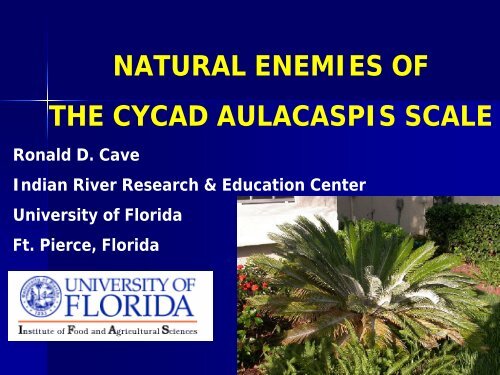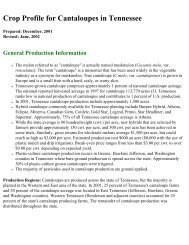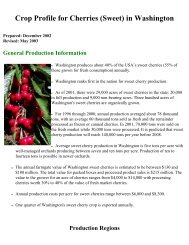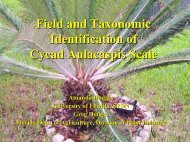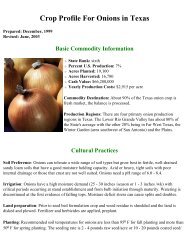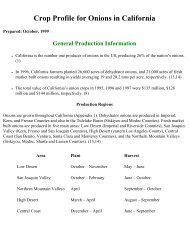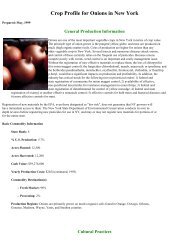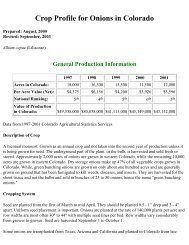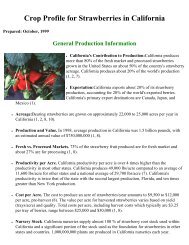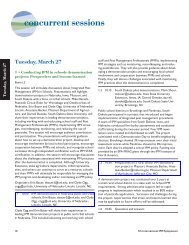natural enemies of the cycad aulacaspis scale - Regional IPM Centers
natural enemies of the cycad aulacaspis scale - Regional IPM Centers
natural enemies of the cycad aulacaspis scale - Regional IPM Centers
You also want an ePaper? Increase the reach of your titles
YUMPU automatically turns print PDFs into web optimized ePapers that Google loves.
NATURAL ENEMIES OF<br />
THE CYCAD AULACASPIS SCALE<br />
Ronald D. Cave<br />
Indian River Research & Education Center<br />
University <strong>of</strong> Florida<br />
Ft. Pierce, Florida
AN OVERVIEW<br />
OF THE PREDATORS,<br />
PARASITOIDS, AND<br />
NEMATODES THAT USE THE<br />
SUCCULENT NUTRIENTS<br />
OF Aulacaspis yasumatsui<br />
AS A FOOD SOURCE
PREDATORS<br />
Coccinellidae – 16 species<br />
Chilocorus cacti<br />
Exochomus childreni<br />
Curinus coeruleus
PREDATORS<br />
Coccinellidae<br />
Cryptolaemus montrouzieri<br />
Diomus austrinus<br />
Olla v-nigrum
Larvae <strong>of</strong> Coccinellidae<br />
Why do we not find more eggs,<br />
larvae, and pupae <strong>of</strong> <strong>the</strong>se beetles<br />
on <strong>scale</strong>-infested <strong>scale</strong> infested plants?
Rhyzobius lophanthae<br />
Generalist predator from Australia but widely<br />
spread for biological control purposes<br />
Voracious consumer <strong>of</strong> CAS in Hawaii and<br />
Tampa, FL; introduced into Guam
Rhyzobius lophanthae<br />
Development time is 34 days at 25˚C<br />
Adults live on average 5-6 months<br />
Female may lay 100s <strong>of</strong> eggs in a lifetime<br />
Can tolerate cold temperatures<br />
No known parasitoids<br />
Commercially available<br />
Why is it not more widespread in Florida?
Cybocephalus nipponicus<br />
(Cybocephalidae)<br />
Native to Asia, released in Florida in 1999 for CAS<br />
control, but already present in <strong>the</strong> state before<br />
<strong>the</strong>n<br />
Larvae and adults are predaceous on many<br />
species <strong>of</strong> armored <strong>scale</strong>s
Cybocephalus nipponicus<br />
Development time is 40 days at 25˚C<br />
Female lays about 288 eggs<br />
Adults live 89-100 days<br />
VERY susceptible to pesticides<br />
Pupae are parasitized by<br />
Aphanogmus albicoxalis
confirmed:<br />
PARASITOIDS<br />
Coccobius fulvus (Aphelinidae)<br />
Arrhenophagus chionaspidis (Encyrtidae)<br />
Aprostocetu sp. (Eulophidae)<br />
found in association:<br />
Pteroptrix chinensis (Aphelinidae)<br />
Aphytis lepidosaphes (Aphelinidae)
Coccobius fulvus<br />
(Aphelinidae)<br />
Native to sou<strong>the</strong>ast Asia<br />
Introduced into Florida by R. Baranowski<br />
95% parasitism initially in Homestead area
Coccobius fulvus<br />
Females develop in 2 nd instar & adult female <strong>scale</strong>s<br />
Males develop as hyperparasites on female larval<br />
Coccobius<br />
Development time is 21 days at 25˚C<br />
Females can live up to 2 months when fed honey<br />
Fecundity w/ CAS as host is unstudied<br />
No o<strong>the</strong>r known hosts in Florida, but attacks arrowhead<br />
<strong>scale</strong> in Asia (fecundity = 60 parasitized hosts/female)<br />
Hyperparasitized by Ablerus elegantulus
% Parasitism<br />
80<br />
60<br />
40<br />
20<br />
0<br />
BY LEAF<br />
y = 1.3x + 14.4<br />
R 2 = 0.13<br />
0 3 6 9 12 15<br />
Scales per cm <strong>of</strong> leaflet<br />
Overall, greater parasitism at higher <strong>scale</strong><br />
densities on a leaf, but<br />
Coccobius fulvus is not doing <strong>the</strong> job we want.
Arrhenophagus chionaspidis<br />
(Aphelinidae)<br />
• Attacks young 2 nd instar male <strong>scale</strong>s<br />
• Cosmopolitan distribution<br />
• A very frequent parasitoid <strong>of</strong><br />
<strong>cycad</strong> <strong>aulacaspis</strong> <strong>scale</strong> in Asia:<br />
70% parasitism in Taiwan<br />
• Present in Florida, but has NEVER been reared<br />
from <strong>cycad</strong> <strong>aulacaspis</strong> <strong>scale</strong> (WHY NOT?)<br />
• VERY difficult to colonize in <strong>the</strong> laboratory<br />
(at <strong>the</strong> moment)
Exploration for additional parasitoids,<br />
and test Aphytis yanonensis<br />
ID species<br />
and colonize<br />
Aprostocetus,
UNFORTUNATELY,<br />
PREDATORS AND<br />
PARASITOIDS<br />
CANNOT REACH ALL<br />
THE SCALES ON A<br />
CYCAD PLANT
ENTOMOPATHOGENIC NEMATODES<br />
% lab infection<br />
Steinernema feltiae 24 (37)<br />
Heterorhabditis bacteriophora 42<br />
Heterorhabditis indica 40<br />
Heterorhabditis marelatus 24<br />
Are nematodes capable <strong>of</strong> controlling <strong>scale</strong><br />
populations on <strong>the</strong> trunk, crown and roots?
ENTOMOPATHOGENIC FUNGI?<br />
Aschersonia aleyrodis
PENDING RESEARCH:<br />
• developmental biology, fecundity, and cold<br />
tolerance <strong>of</strong> Coccobius fulvus,<br />
Arrhenophagus chionaspidis, and<br />
Aprostocetus sp.<br />
• exploration for and study <strong>of</strong> new exotic<br />
parasitoids from Asia<br />
• feeding studies <strong>of</strong> select coccinellids<br />
• experimental releases <strong>of</strong> Rhyzobius<br />
• field applications <strong>of</strong> nematodes<br />
• testing <strong>of</strong> Aschersonia


